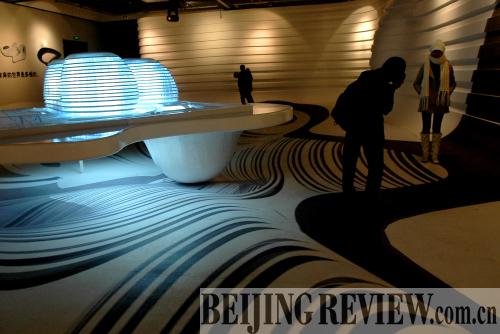|
 |
|
DESIGN IS STRENGTH: The exhibition with the theme "Design as Productive Force" tells stories of brands (LI WENMING) |
Design and Innovation—An International Industrial Design Show explored the relationship between design, technology and economic development of the past, present and future, focusing on the achievement and trajectory of China's emerging design industry, and demonstrating the latest trends in global design.
It was set in three scenes—Beijing, China and the rest of the world, illustrating design products in priority development fields including equipment manufacturing, consumer electronics, medical devices and urban industry.
This year's IWDC also included an independent exhibition of new energy automobiles, entitled "Green Walk." The show tapped into the fast-growing industry's creative potential, showcasing the latest achievements in new-energy vehicle design and endorsing a campaign for a healthy lifestyle.
An exhibition with the theme "Design as Productive Force," which told stories of brands, was held at the National Art Museum of China. "Now the economic development of China depends more on producing than on creating," said Gu Shengzu, a lawmaker at the National People's Congress. "This cannot last long. In the near future, I dare say that design is the productive force."
As for graphic design, The Most Beautiful Book—the Seventh National Book Design Exhibition kicked off on October 25 at the National Center for Performing Arts. It told the story of book design, including cover design and page design over the past decades.
Another exhibition, Chinese Graphic Design in the 20th Century: A Documentary, chronicled history dating back to the 1900s. It showcased design objects such as Chinese posters, magazines and newspapers from the 20th century, and other graphic design-related objects, individual profiles and relevant documents, forming a comprehensive presentation and interpretation of design development and the social life of China in the 20th century.
Compared with these, the New Typography exhibition was a shining and unique part of this year's IWDC.
The exhibition showed design works based on Chinese characters and foreign words. It originated from the idea of Jan Tschichold, who published his most noted book The New Typography in 1928. The German typographer and book designer expounded on how typography must make itself "part of all the other fields of creativity."
Contemporary typography demonstrates new possibilities—both in terms of words and images, and in form and concept. Chinese characters, for example, indicate either pronunciation or meaning or both. Moreover, in its 5,000-year history, the Chinese language has evolved into a highly sophisticated writing culture. Furthermore, the idea of calligraphy as a "sophisticated art" has influenced many countries worldwide.
The exhibition also discussed how to deal with challenges confronted by typographical designers nowadays, such as the migration from traditional writing and mechanical systems to a digitalized one.
Views
Together with all the exhibitions, the various forums were the big attractions of this year's IWDC. Chinese designers had lively discussions on the purpose of design, the style of design and how to produce good design and so on. Among all the topics, the hottest issue was the concept of why designs are made.
"Designers don't design for handing their name down," said Wei Lai, President of Morning Design Co., a famous Beijing-based firm. "How many people know who designed Benz, who designed the Nike logo, who designed the TV you watch at home? Who designed the clothes you put on?" he asked. "All the successful commercial design works are from adapting to the needs of customers."
But "successful designers are always good listeners," Wei noted. "They listen to the needs of people and combine the functional elements and aesthetical elements together."
The nature of design is to solve problems, according to Chen Dan, chief designer of Zhengbang Group Co. Ltd. Every time after he made a design, Chen said, he would stand in the street and ask passers-by whether they thought the design was good or not.
Xu Bing, Vice President of China Academy of Fine Arts, echoed these remarks."Don't do design just for design's sake," he said. "Good designs and arts should deal with the relationship of social development. Only in this way can design be smoothly involved in the society." | 